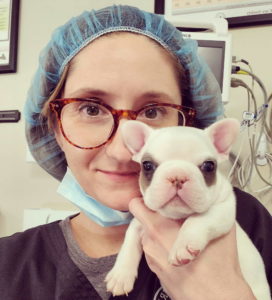EPISODE 216 | RELEASED May 15, 2023
Emotional Experience of Pain in Dogs | Tasha McNerney CVT
Is my dog depressed? If you’ve asked this question, the behavior changes you are seeing may indicate that your dog has chronic pain.
SHOW NOTES
We know that humans who endure chronic pain often also experience anxiety and depression. So what about our dogs?
Vet Tech Specialist Tasha McNerney explains some of the behavioral changes you might see if your dog is experiencing chronic pain, as well as a variety of the different medications and therapies that can be used to help relieve or prevent that pain from occurring.
And while we don’t know for sure yet, it is also possible that dogs who are constantly stressed out become more sensitive to pain and experience discomfort, just like people do.
Listen in to learn how to recognize possible chronic pain versus acute pain, what conditions might cause chronic pain, and when to seek veterinary help if your dog just doesn’t seem right.
Links Mentioned in Today’s Show:
Pain Scoring Systems from North Carolina State University: https://cvm.ncsu.edu/research/labs/clinical-sciences/comparative-pain-research/clinical-metrology-instruments/
[00:00:00] >> Tasha McNerney: We know that chronic pain states or untreated pain will produce behavioral and emotional changes in animals, but since it does happen a lot in humans of the other way around, I think it’s completely plausible that it would happen in our dogs as well.
[00:00:14] >> Announcer: Welcome to Dog Cancer Answers, where we help you help your dog with cancer.
[00:00:20] >> Molly Jacobson: Hello, friend, I’m Molly Jacobson. Today on Dog Cancer Answers we have a guest you’ll recognize, veterinary technician Tasha McNerney. Today we’re going to dig a little deeper into something Tasha mentioned in an earlier episode, the relationship between emotional state and pain. It turns out our dogs don’t live in vacuums and their mental state can impact how they feel physically and the other way around.
Tasha McNerney, thank you so much for coming back to talk to us about pain.
[00:00:54] >> Tasha McNerney: Yeah. Thank you so much for having me.
[00:00:56] >> Molly Jacobson: I’m really excited about today’s topic as we were talking before the recording started, because I think a lot of us know that the emotions that we feel, feel bad, and it sounds to me like we’re starting to see that show up in the data and the science that the emotional component of our lives is not distinct from the physical component of our lives, and that’s also true for dogs. Is that a good enough introduction for what we’re gonna talk about today?
[00:01:26] >> Tasha McNerney: Certainly. Yeah. And it’s very true. There is an emotional component to pain, and we know this in humans, right? Anybody here listening who has ever experienced chronic pain or even a, a, a temporary like post-surgical pain knows that it can mess with your emotions and the emotional processing can actually in turn make pain worse sometimes.
[00:01:53] >> Molly Jacobson: So pain that you feel physically can make you feel bad emotionally, mentally, which can make you feel bad physically, which can make you feel bad emotionally and mentally, which can make you feel bad physically. And like, in the physical world, we say pain, spasm, pain cycle where pain causes spasm, which causes pain. But there’s also emotional pain, pain cycle it sounds like.
[00:02:17] >> Tasha McNerney: 100%. We see this, um, especially in chronic pain. Now again, there’s a lot of literature out there about human medicine and chronic pain states. And the fact that we do, from a lot of research across a lot of different things, see that in humans there is an emotional component.
It’s taken a little bit of time for the veterinary community to catch up with this, but now we also have multiple studies showing that pain, especially chronic pain, and pain associated with either postoperative, maybe, you know, post limb amputation following an osteosarcoma or some type of internal tumor, is going to cause a chronic pain.
And when we have chronic untreated pain, that can lead to emotional distress, right? And we see a lot of ways that animals will show that they’re in pain, right. We know from different, their body conformation and their facial scoring – we have a lot of good chronic pain scoring systems.
However, we can tell from behavioral clues from dogs that they are in pain or we’re not treating their pain appropriately. Because I do, and my area of focus is anesthesia and pain management, we do work with a lot of animals that are maybe postoperative or they might be in hospice care and they’re on different multimodal pain medications.
However, we’re always talking with the clients to see, you know, has their emotional state changed. Right? So I’m always talking with my clients at these rechecks, do you notice any defensive behavior, especially if around their areas of sleeping or areas of eating.
Have you noticed, and we see this a lot in cats, have you noticed ramping up of aggression. Right? One of the classic ones that we saw with a cat that was a chronic pain cat that turned out to have an osteosarcoma lesion in their front paw, over time what had happened is the cat always jumped up and sat with the owner and would watch television with the owner, right?
And she would pet the cat. And she noticed over time that the cat, A, didn’t wanna jump up. So that’s a first clue, right? But then second, when she went to go pick the cat up, just her touching the cat’s back or the cat’s belly, so not the area where the actual lesion was, but other areas, now the cat’s reacting with aggression.
And this is because those untreated pain signals have caused what we call a mix of first, hyperalgesia, and then second, allodynia. Right? So, what happens with these pain signals as they’re going, if pain is not properly treated or, and we can talk about this in a minute, if we’re using improper methods because maybe we’re using a drug that really is meant for visceral pain when we’re, when we have a little bit of somatic pain, and that’s our problem.
But if these pain signals keep going through to the spinal cord and to our central processing, hyperalgesia just means that as we keep going, more pain receptors are gonna be open and ready for action.
[00:05:18] >> Molly Jacobson: So hyper meaning more, and analgesia, meaning pain?
[00:05:22] >> Tasha McNerney: Yes.
[00:05:22] >> Molly Jacobson: So literally just, more pain.
[00:05:24] >> Tasha McNerney: Exactly.
[00:05:25] >> Molly Jacobson: Okay.
[00:05:26] >> Tasha McNerney: So as we have more of these receptors that are open and ready for pain, we then start going into our central nervous system. And as more of our central nervous system is getting turned on and activated, we switch over to something called allodynia, and this is what that cat was experiencing. And that’s where now any sensory input coming in is eliciting a painful response.
[00:05:49] >> Molly Jacobson: Oh.
[00:05:49] >> Tasha McNerney: So she was picking the cat up near its abdomen or its back, and now the cat is, it’s ramped up and ready to go. So that touch signal goes into the spinal cord and goes up to the brain and goes, wait, pain, pain. It’s not really pain, but because these neurons are ready to go and they’re primed for pain because of these untreated other signals down the line, they’ve now caused this kind of what we call like receptor soup, where all of them are kind of confused and sending signals that aren’t the correct signals.
And we really gotta control that pain because again, we know that untreated pain over time is going to cause problem behavior. And sometimes we see animals come in and they actually will be a behavioral euthanasia because it’s really untreated chronic pain that’s happening.
[00:06:38] >> Molly Jacobson: Oh, how sad.
[00:06:40] >> Tasha McNerney: Yes. But what’s good is that then we can have a conversation with the owner about some of the behavior problems. Like a lot of times with cats, again, if they have maybe a lesion in their spinal cord or something like that, deep pain in their abdomen and just the act of walking up or getting over a litter box, now they’re house soiling, right? So the house soiling is the behavior that brings them in for a consult or even, you know, sometimes we see in a euthanasia. But we’re able to have that conversation with the owner because again, we know that pain is going to affect the emotional health of the pet, right?
And I use this a lot in some of my lectures that I do, and especially with dogs, and dogs with chronic pain, dogs that maybe, again, have had lesions and they have had either amputations or surgery, we know that if that pain is not well controlled during the period of surgery and in the immediate postoperative period, again, those pain receptors can get activated and over time lead to more pain receptors getting activated and then it kind of catches fire, right, up into the central processing.
So a lot of times I wanna talk with owners, especially if you have a dog that has maybe had a splenectomy and had a tumor removed and or they’ve had a front limb amputation, right, just because we get the sutures out in eight weeks doesn’t mean that that pain is completely gone. And I, as a pain professional in veterinary medicine, I wanna continue to have conversations with the owner, you know, maybe two months, three months, six months down the line. How are things going? Tell me about the emotional, you know, tell me about his emotions.
Is he guarding his food? Are we having any issues, you know, when you’re walking? Does he get aggressive if you try to touch his hind end or somewhere that normally wouldn’t elicit pain. Those are big signals that maybe those pain receptors haven’t been properly addressed.
[00:08:31] >> Molly Jacobson: Wow. So the effects of a painful event, if you don’t control pain upfront and then continue to monitor for pain and, and intervene as necessary, like I can totally get as an owner, like just not associating my dog’s current, what it seems like to me is like she’s kind of, I don’t know, guarding her food or she’s more irritable or she doesn’t like to be pet as much.
I can absolutely understand how that would be very difficult to tie back to a surgery that happened 4, 5, 6 months ago or a year ago, especially when you see your dog every day, so you get used to the way they are. How can people know?
[00:09:10] >> Tasha McNerney: So there are different pain scoring systems that are out there. And I will say that a lot of the pain scoring systems that we do use in veterinary medicine are designed for more acute pain because that’s what we’re dealing with usually as you know, something comes in, it’s acutely in pain or you know, worst case scenario, it’s experienced a major trauma, we’re dealing with acute pain.
[00:09:30] >> Molly Jacobson: Okay.
[00:09:30] >> Tasha McNerney: However, there are some pain scoring systems out there that are made specifically for animals that are dealing with chronic pain, and there’s a really good one out of the University of North Carolina, so, you know, if you Google, I think it is the North Carolina Animal Pain Index.
[00:09:48] >> Molly Jacobson: Okay.
[00:09:48] >> Tasha McNerney: Uh, it’s run by Duncan Lascelles, who’s a really fantastic researcher in chronic pain in animals. But it gives owners kind of a step-by-step look at how has your dog’s emotions changed. You know, are they still excited to go on a walk, are they slow to rise, do they have more fear and reactivity and aggression? All of those things will point to potentially a chronic pain issue or, or pain not being addressed properly.
[00:10:16] >> Molly Jacobson: Wonderful. So if you are feeling like your dog just isn’t themselves, would that be sort of a, a first gut check of like, maybe there’s something painful going on in my dog that I don’t recognize, that I don’t know about.
[00:10:31] >> Tasha McNerney: Yes, certainly.
[00:10:32] >> Molly Jacobson: Okay.
[00:10:32] >> Tasha McNerney: So I always say that, you know, as veterinary professionals, I, I have a lot of letters after my name and I have a, a couple of degrees that say I really know what I’m talking about. However, in my mind, the owners are really the people who know their dog the best. And so if you’re the one spending all of that time with your dog and something is just not right, and you know it, and you feel it in your gut, go with that, okay. And then talk to your veterinarian. Give them a call or talk with the, a veterinary technician. Or if you’re really lucky to be in one of the states that has a certified veterinary pain practitioner in them, give them an email or something. We’re always, in veterinary medicine, really, you know, we wanna be there for you and to make sure that, you know, we’re supporting you in this.
You know, no one is ever overreacting. I, I wanna make sure that I am supporting clients through all of this, because like a lot of times, especially if they are dealing with an animal who is, you know, post-surgical for a tumor removal or even dealing with hospice care, they’re probably correct in their assessment.
And so how can I then take whatever the animal is currently on as far as pain control and change it, again, to make it maybe a little more multimodal so the owners and the pet can have the best experience possible.
[00:11:47] >> Molly Jacobson: So when you see someone come into your clinic, and their dog’s already on a pain medication, but it’s clear to you that it’s not working, how do you address that?
[00:11:57] >> Tasha McNerney: Sure. So we see this a lot of times, and this is because often in veterinary medicine, we’re going to usually start a patient out on maybe the easiest option. So most often, if it’s chronic pain, we’re starting them out on a non-steroidal anti-inflammatory, as long as their kidney and liver values are healthy.
However, we know from a mountain of evidence that single agent doesn’t usually work best at controlling pain, especially chronic pain. So if I have an animal that comes in and I feel like they’re pain scoring high, right, or the owner says to me, yeah, he’s really defensive in his behavior, I’m seeing increased signs of aggression, not interested in going on walks like we used to, and he’s still on a non steroidal, let’s talk about some other things that we can add in order to make that patient have the best experience possible.
We have to remember that we have to look at what type of pain we think is going on with the animal, right? Do we think that this pain is arising from like a visceral spot, right, so somewhere deep within the abdomen in the viscera, or do we think this is more somatic pain or pain that’s arising from like within the bones or the skin or the nails and that kind of thing? So those types of pain are treated differently by the drug classes that we choose.
And so non-steroidals are a great drug class, and they’re very effective for inflammation or osteoarthritis and some forms of chronic pain, but they might not be the most effective for every type of pain. And so we really wanna do a comprehensive exam and talk with the owner and figure out where is that pain exactly arising from, right, because certain drug classes are gonna work better on certain types of pain.
Then I’m gonna talk to the owner about the feasibility of adding in some non-pharmacological or multimodal analgesic experiences. And these are things like massage therapy, acupuncture therapy, hydrotherapy, passive range of motion, for our patients. So we’re gonna do things like that and talk with the owner and see how feasible is it for them to either take their dog to a practitioner of these or learn some of the techniques themselves, right?
Because we have a lot of owners who are very hands-on and they will learn the massage techniques for their dog, or they will learn if we have a, a smaller dog that will benefit from something like hydrotherapy, right, they’ll learn the appropriate water depth and the exercises that they could do some hydrotherapy exercises at home. There’s even, again, some acupressure points that owners can learn at home to help relieve some of these painful areas.
So while drugs and pharmacology are really important, it’s also adding in the non-pharma things that make a difference as well. And then we have other things like supplements, right? There’s a wide variety of supplements out there that can help with pain and analgesia. We have a lot of research, especially in chronic pain, on things like CBD in dogs. So there are a lot of options for owners.
So if they come in to me and they may have a dog on just one analgesic or one pain medication, and either it doesn’t seem to be working and their dog has a reaction to it, there are so many other options out there that we can look at.
[00:15:14] >> Molly Jacobson: That’s wonderful. So I really wanna make sure that we, our listeners and myself, as a layperson, I really wanna understand what the dog’s emotional pain looks like, what those signs are that I can notice at home to let me know that they’re in a chronic pain situation or could be in a chronic pain situation, and that they actually need to go to the vet. It’s not just them like, having a personality change or it’s not something to dismiss.
[00:15:44] >> Tasha McNerney: No, it’s not something to dismiss. And one of the things that you brought up right there, a personality change. For us in veterinary medicine, a personality change is usually a big red flag that there’s some form of untreated pain. Oftentimes we see this with neuropathic pain that has gone untreated. A lot of times we will see neuropathic pain in things like maybe a, you know, for instance, I’ve had one before in my practice where it was a Greyhound. The dog had a front limb amputated and unfortunately was only sent home with one type of pain control.
And again, when we talk about chronic pain and making sure that we don’t have chronic pain happening, we wanna prevent it with a multimodal protocol. So this is multiple different drugs from different drug classes working on different receptors to make sure that we are preventing this allodynia from even starting.
So there are a lot of different ways that we can, can, again, attack pain, but for us as pet owners, right, if my dog is telling me that they no longer wanna go for that walk or their personality just changes, whereas before, they were super excited to chase that ball and now they maybe pick up the ball and they immediately drop it, right?
We see this sometimes with oral tumors or oral pain in general, where they aren’t chewing their kibble as well as they used to. They aren’t as interested in picking up or playing with the toys or the ball. Any of these behavioral changes, that’s a red flag, so I wanna know about. And what’s nice about now having technology is that I can ask owners, Hey, you know, during feeding, if you are noticing some of these things, you know, if there’s mouth pain, or with cats, you know, if they have difficulty jumping or, or going up the stairs. Take a video of it, right?
Videos are so helpful for us in the veterinary profession because we can’t be there in your house all of the time to see exactly what’s going on. But this gives us a big insight. So if you see your dog experiencing anything that you think is a change in behavior, please take a quick video of it, and that’s gonna give us a lot of insight as to whether or not we think this could be a joint related pain, a neuropathic pain, an osteoarthritis pain, deep abdominal pain we see, right, there are certain body postures we see with abdominal pain.
So if we see something like that on video, that’ll give us a good kind of next step, okay, here’s what medication we should prescribe for this.
[00:18:07] >> Molly Jacobson: Wonderful. Okay, so personality changes could be a sign of pain, is a big red flag for you. How else are dogs communicating their emotional and chronic pain states to us?
[00:18:18] >> Tasha McNerney: Yeah, so there are a couple different, and it really depends on the personality of the dog as well. And again, you guys as pet owners know your dogs the best. But if your dog was usually attached to your hip and now has become extremely withdrawn, that’s a big sign. We see this in cats as well, right? Cats will go from being social, and not that cats are wildly social all the time anyway, but we see that. But with dogs, dogs are very social and they usually are very attached to their owners.
So if we see where a dog now is being extremely withdrawn, won’t come downstairs with the owner in the morning, doesn’t wanna get off the bed. For mine, like we just adopted a, a really small little nine year old Chihuahua and I’m constantly like evaluating him for could he be in pain, ’cause he’s only been with us for two weeks.
And in my mind, a nine year old Chihuahua has to have pain somewhere. So I’m constantly looking at, you know, how is he walking? Does he get excited when I pull out his harness? Right? And he does. He really does. And so I know he enjoys going outside and going on his walks. So if we get to a point where I’m pulling out his harness and he doesn’t even get off the couch, or he goes really slowly, or I don’t see those tail wags like I used to, that’s a sign that something’s going on and I need to investigate that further.
[00:19:38] >> Molly Jacobson: Okay. That makes a lot of sense. And I think a lot of times people just think, well, they’re getting older, don’t wanna go on walks as much.
[00:19:45] >> Tasha McNerney: Exactly.
[00:19:46] >> Molly Jacobson: But why do humans don’t wanna go on walks as much when they get older? It’s probably ’cause they’re in some kind of pain.
[00:19:52] >> Tasha McNerney: Yes, it is. Right? We know that, again, chronic pain does affect us emotionally. And there was an interesting study from the American Journal of Psychology that looked at about, I think it, the statistic was 70%. It was a really high number of people who have chronic pain that also report feelings of anxiety, depression, et cetera.
So if we have those things, we’re all mammals and we have kind of the same structure as far as our brains stem and our central processing goes, we have to extrapolate that we’re gonna see the same things in animals. And we do, and we have studies to support that. We know that we see aggression, right? We know we see withdrawnness and depression in our dogs when they are in states of chronic pain.
[00:20:40] >> Molly Jacobson: Okay, I know there’s a lot of people listening who are thinking, but I told my vet that my dog was depressed and he didn’t believe me, or he dismissed it or she said, that’s not true, dogs don’t get depressed. ‘Cause I know that this is new thinking. Am I right?
[00:20:55] >> Tasha McNerney: You’re right. This is new thinking.
[00:20:57] >> Molly Jacobson: So we can all kind of say, all right, it’s new thinking and we can forgive people who didn’t know this before because it wasn’t something we knew before, but now we know that dogs have emotions and they impact their physical experience in the world, just like our emotions impact ours.
[00:21:15] >> Tasha McNerney: 100%. And if you feel like you’re not getting buy-in from your veterinary professional, maybe you could change your wording, right? So I would say that veterinary professionals, our ears are gonna perk up more if you say, I’ve noticed behavioral changes, instead of just saying, I think my dog is depressed. Right?
[00:21:33] >> Molly Jacobson: Uh huh.
[00:21:34] >> Tasha McNerney: And that’s not to say that we are just inherently being dismissive. But our brains in science, in vet med, are trained to pick up these keywords. So if you say to me, well, again, I would say as a pain practitioner, I am trained to hear my dog is depressed, so to me that’s a red flag. But for a lot of people, maybe it’s not. And so use the words like, my dog is having a behavior change, I wanna talk about this. And especially, especially if your dog has been dealing with any chronic pain state or previously had a major surgery in the past year, bring that up with your veterinarian.
[00:22:10] >> Molly Jacobson: Good point, that things that happened a year ago could be affecting your dog today.
[00:22:15] >> Tasha McNerney: Yes.
[00:22:16] >> Molly Jacobson: Tasha, do you think it’s fair for us to think that things that would hurt us emotionally, physically, mentally, are things that might hurt our dogs as well?
[00:22:27] >> Tasha McNerney: 100%, yes. Of course. We know, again, we do have some studies to show that even emotional environment can affect the stress cortisol and heart rate levels of animals. So if animals are present in a situation that is people fighting, very loud voices, stress, we know that the animals can feel that in the room and their heart rate and their stress cortisol levels can be affected by this.
Interestingly enough, they did a study looking at the types of music played around dogs, and they found that music that was very intense, like, you know, heavy metal music, cause dogs to have a higher heart rate and become more anxious in their kennels. So it is very easy to see that dogs can be affected by their environment as well as whatever’s going on within their body.
[00:23:25] >> Molly Jacobson: Okay. That’s important. I mean, we’ve been saying for years on Dog Cancer Answers that dogs pick up on our emotions, and you’re saying they absolutely do. So what does a person do who maybe, I mean, I have a history of having a low mood for sure, and many, many people do. A lot of Americans, for example, have anxiety disorders these days. And I think we’re being more open about mental health as being an actual issue that needs to be addressed.
So if you are, someone listening is struggling themselves and they hear this, well, I can testify for myself feeling guilty that now, oh and great, not only am I depressing myself, I’m depressing everybody else around me, and I’m depressing my dog. Like, like, like what message of hope or grace or kindness and compassion can you offer to those of us who feel like bad moms?
[00:24:20] >> Tasha McNerney: No. Yeah. I mean, and I have a dog now and a son, so the guilt is real all around. But you said it perfectly. You gotta have some grace with yourself because this is stressful. And especially if you are the parent of a dog that is dealing with chronic illness or you’re a caregiver in any way, that’s inherently stressful. So give yourself some grace. Realize that we are not gonna be perfect all of the time.
And as long as you have that awareness and you have a good either support circle, whether it be within your own home and your family, or a support circle within your veterinary community – I will say that a lot of veterinary offices nowadays are creating support groups, whether they’re on Facebook or an in-person support group, but a lot of veterinary offices will offer support group for owners whose canines have cancer or are dealing with hospice care or have recently passed.
So there are support groups out there. So, you know, do whatever you can that you’re gonna be comfortable with to get a support group around you. Because it’s true, we’re all gonna have our days where we are not 100% perfect, and we’re not creating this lovely spa-like environment in our homes. Right? That, that’s just gonna happen.
But I think if we have the awareness to know that not only is it going to affect us emotionally, but it’s going to affect the other people in the house, even the canine people in the house, that’s something to kind of keep in mind.
[00:25:46] >> Molly Jacobson: That’s really good. Self-care is such a buzzword these days, but there truly is a need for us to take care of ourselves and we can’t fix all of our problems and make the problems go away, certainly not cancer, in our beloved dogs.
But we can take a few steps to take some deep breaths and reorient ourselves or try not to have that fight, perhaps, to get the support that we need in our lives so that we can, yeah, make it better for all of us. ‘Cause it’s like, right now I’m looking at a house with, let’s say a parent, a child, and a dog, and thinking, you know, if there’s a lot of stress in that atmosphere, that’s a lot of people who are being affected by it.
[00:26:24] >> Tasha McNerney: 100%. Yeah.
[00:26:26] >> Molly Jacobson: This feels like a good point to take a break and go hug our dogs. We’ll be right back with more from Tasha McNerney.
And we’re back with Tasha McNerney, talking about the relationship between emotions and pain in our dogs and how to recognize when something’s amiss. So we have change in personality and change of behavior, like not wanting to go on walks, things like that. Is there anything else?
[00:26:54] >> Tasha McNerney: Yes, if they have change in their feeding, any kind of change in appetite we usually wanna know about. Now, every once in a while, a dog is like, Hey, I’ve been eating this same kibble for 10 years and I want something different. Every once in a while we do see that, right? Most of the time dogs are not discerning connoisseurs, but every once in a while we do have some that are, and so it makes sense, right? Let’s try something different with their diet.
But if they’re really having an issue where they’re either having difficulty eating and can’t either pick up or chew kibble, or they completely turn their nose up at food or become nauseous around food, those are key signs we want to know about those as veterinary professionals. So if you see things like that, definitely that could, you know, point to some deep abdominal pain and we want to know about that as soon as possible so we can get your dog on some appropriate medications, maybe make some food changes if needed.
[00:27:48] >> Molly Jacobson: Okay. Very good. Are there any other pain signals that we can pick up on at home?
[00:27:54] >> Tasha McNerney: At home? Certainly. So at home, again, I think that really the biggest things are usually around sleeping, eating, and exercising. So if you have a dog that is usually high energy and they normally like to go, either you take him to the dog park, and at one point this was a dog who would chase the tennis ball, or they would chase the Frisbee, et cetera, and they’re not finding joy in things that they once did find a lot of joy in, again, that’s another red flag for me. Because you know, my dad’s Labrador loves to chase the ball.
And on the day that he doesn’t wanna chase that ball or he just stops and looks at the ball, there’s something going on and we need to investigate that further. And I know that with things like chronic osteoarthritis and pain like that, there is just gonna be some component of pain because osteoarthritis is not something that we can completely get rid of, right? Osteoarthritis is something that we manage.
But if the dog doesn’t wanna chase the ball because of osteoarthritis, that means we’re not managing it very well, and we need to look at other tools and ways that we can manage it even better.
[00:28:59] >> Molly Jacobson: Okay, very good. There’s a concept of, I’ve heard about windup. Can we just talk a little bit about that?
[00:29:05] >> Tasha McNerney: Yeah. So windup kind of goes along with the hyperalgesia.
[00:29:10] >> Molly Jacobson: Okay.
[00:29:10] >> Tasha McNerney: And if your listeners really wanna get into it, they can read about something called gate control theory. And this is where there is, uh, basically like a gate, right, that lets certain ions and nerve impulses go through. And over time, the correct impulses will go to your brain, right? And they’ll say that, I am touching a dog right now, this is not painful, this feels soft. Or, I am touching a hard rock, or this is pressure, this is heat, et cetera.
However, over time, if pain signals keep sneaking in there, sneaking in there, they’re gonna start to override the gate, basically, and they’re gonna send these signals up into the brain where now the brain is like, wait a minute, I thought that I was only letting touch signals get through, but this is a pain signal and I’m kind of confused, and now I just feel pain.
And the more that they get through and the more that they get through, right, our patient experiences this wind up where those signals are just building and building and building until we get to a point which we refer to as allodynia, where now any signal, whether it be pressure, whether it be soft brushing against the skin, anything that’s coming in as a signal is interpreted to the brainstem as a painful signal. We see this a lot with chronic pain and especially chronic skin infections, chronic ear infections in dogs.
So where, you know, with this chronic ear infection, they’re very, very painful. They’re very inflamed. They can’t get that pain under control. And eventually we’ll see the Cocker Spaniel that comes into us and we go to give him a little scratch on the hiney and he turns around and tries to bite because that scratch on the hiney, that is interpreted, that is a painful signal now to me. Every input is painful input.
[00:30:55] >> Molly Jacobson: That’s very sad.
[00:30:56] >> Tasha McNerney: It is very sad. But luckily, again, we have tools to break that wind up cycle, to break that pain. We just have to determine, you know, what is gonna be the best course of action pharmacologically and non-pharmacological, ’cause we wanna do both, for the dog.
[00:31:12] >> Molly Jacobson: Okay, that makes sense. So when your dog has a surgery and your vet sends you home with multiple pain medications, I know a lot of people who think, my dog doesn’t need all of these pain medications. And dogs are stoic, so they may not act like they’re in pain or we are not understanding that they’re in pain. And if you don’t give those medications, you’re running the risk of starting this process of wind up that can lead to chronic pain.
So would your position be to just give them as prescribed even if your dog doesn’t seem to need them?
[00:31:47] >> Tasha McNerney: 100%.
[00:31:48] >> Molly Jacobson: Okay.
[00:31:48] >> Tasha McNerney: We always say to finish the course of analgesics as prescribed. So if your dog has been sent home with three to five days of pain medication post-surgery, or again, if they’ve had a major surgery, like a big amputation or something like that, then usually they’re going home with, you know, at least a week to two weeks’ worth of analgesics.
It is really important because again, we wanna make sure that none of those pain signals are sneaking through. Because the more pain signals that start to sneak through, you guys know, and anybody here who’s ever dealt with, you know, kind of chronic back pain or chronic shoulder pain, you have days where those signals are just sneaking through and you’re almost debilitated, and again, causes some mood swings and it’s really uncomfortable.
And it becomes much harder actually to control the pain once it’s reached that level because it’s easier to control a light inflammation and a few pain signals sneaking through. Once we have lots of pain signals sneaking through and we are fully in wind up, it’s gonna take a lot more drug to control the pain. And the unfortunate thing is with more drug, that means more side effects, right? So we’re trying to keep it where we’re giving low levels of the analgesics in the beginning. Control the pain while it’s small, and then get rid of it.
[00:33:03] >> Molly Jacobson: One of the things that comes up a lot in our forums is that people question the use of gabapentin. Their dog is sent home with gabapentin and they don’t understand why this kind of medication that it’s not intended for use in pain, it’s not an NSAID, it’s not a pain reliever, why are there dogs on gabapentin, after surgery, for example, as one of the medications. Can you talk a little bit about that drug and why it’s used?
[00:33:28] >> Tasha McNerney: So we do in veterinary medicine use gabapentin quite a bit. And it is interesting and, you know from an owner perspective, to look at this and say, wait a minute, this is labeled in human medicine as an anti-convulsant. Why are we using this as an analgesic in our canine friends? But what we’re finding and what some of the research shows, and in human medicine, they do actually use it in this way. Yes, it is used as an anticonvulsant, but gabapentin and the even kind of newer, hotter drug of pregabalin that is associated with it-
[00:34:01] >> Molly Jacobson: Okay.
[00:34:01] >> Tasha McNerney: -they have been shown to be active in neuropathic pain pathways and specifically working on the NMDA receptor, which is the receptor that also drugs like ketamine work on. So we know that for neuropathic pain specifically, we do see an action that benefits canines pain wise, right? And it works for humans as well.
Now, the caveat is this is for neuropathic pain. And to get the benefit of gabapentin, you really have to be on it long term. So animals that are being sent home with three to five days worth of gabapentin are not seeing the full benefits. Because you need, I think that it was at least 24 to 48 hours of a basically like loading time for gabapentin, if you’re using it for neuropathic pain.
It’s a great drug. If I have an animal, for instance, the Greyhound that we talked about earlier, any animal that’s gonna get a big amputation where we’re cutting through a lot of nerves and we might deal with neuropathic pain, we wanna get that animal on gabapentin ahead of time before the surgery. And then keep ’em on it, usually two to three weeks post-surgery.
So this is a drug that it’s, again, used long-term for pain control. If it’s used for short duration, we’re usually only seeing the sedative effects of it, and we are not getting the full analgesic effects of it. Hopefully that makes sense.
[00:35:30] >> Molly Jacobson: I think so. So it’s specifically targeting nerve pain and it is interrupting those nerve pain signals, so they don’t really reach the brain fully.
[00:35:41] >> Tasha McNerney: Exactly.
[00:35:42] >> Molly Jacobson: The brain doesn’t really know those nerves are in trouble. That makes a lot of sense.
[00:35:46] >> Tasha McNerney: Yes.
[00:35:47] >> Molly Jacobson: So yeah, you get an amputation, you cut through all of those nerves. There’s a lot of nerves telling the brain, I’m not, I’m not happy right now. I’m really badly damaged. The brain can then start to panic and try to manage that pain and start to become hypersensitive to all pain signals and then to all signals as pain. So I get it. That’s interesting. And using gabapentin before the surgery, that makes sense.
[00:36:14] >> Tasha McNerney: Yes.
[00:36:14] >> Molly Jacobson: And then for a long time afterwards. So it’s kind of like just taking those nerve pain signals offline for this big event where you don’t want them to be thinking, you don’t want the brain to really notice.
[00:36:25] >> Tasha McNerney: Exactly. So again, if we’re talking about an amputation, which is where we see gabapentin used quite a bit, we’re gonna get them on this medication beforehand because again, it does take a little bit of a loading dose to get into the body, into the bloodstream ,and to get at effective levels. And then again, we’re combining it with things like opioids together with long-lasting local anesthetics, right?
So we wanna do whatever we can so that we’re getting multiple pain pathways, right? That’s why we just don’t send amputations home with one analgesic. I don’t wanna send ’em home with like, just codeine. I wanna make sure that not only are they getting maybe a little bit of codeine, but they’re also getting the gabapentin and then they’re on a local anesthetic as well. ‘Cause if anybody here has had surgery, you know how important, you know, a local anesthetic or a block or an epidural or something like that is.
[00:37:15] >> Molly Jacobson: Right. That makes sense. There’s lots of ways the brain senses pain. There’s not just one path to the brain that says painful. So you’re looking to interrupt that signal in lots of different ways so that the dog really just stays more comfortable throughout all of this.
[00:37:31] >> Tasha McNerney: Exactly.
[00:37:31] >> Molly Jacobson: Okay.
[00:37:32] >> Tasha McNerney: Yes.
[00:37:32] >> Molly Jacobson: And that’s why gabapentin is being used long term, is to keep that cycle going so that as the nerves heal and all of that tissue heals, they’re still getting the benefits of that basically kind of like a, almost like a nerve block in a way. Is that fair? It sounds like it.
[00:37:50] >> Tasha McNerney: It’s fair in the sense that it, at the NMDA receptor, yes. It doesn’t function the same way as a nerve block when we use something like lidocaine or bupivocaine or something that’s a sodium channel blocker. So it’s not working on the exact same channels or receptors, but yes, in the same theory, when we look at how those signals are sent up into the spinal cord.
[00:38:10] >> Molly Jacobson: Okay. That’s great. I think that’ll help a lot of people who wonder. And gabapentin does make the dog a little drowsy often, and sometimes they can get uncoordinated and that can really panic people, make people think, my dog can’t walk on gabapentin. Would you say that’s just a unfortunate side effect to bear with, or should doses be adjusted, or?
[00:38:31] >> Tasha McNerney: It can, and it depends on the dosages. But gabapentin has a pretty wide dosing range. And another thing with gabapentin is that really for it to be effective for pain, we need to be dosing it really every eight hours. So what we probably should be doing is doing smaller doses every eight hours instead of these larger doses every 12 to 24 hours.
[00:38:56] >> Molly Jacobson: Ah.
[00:38:56] >> Tasha McNerney: And then where we do see more sedation from those. So usually yes, it can be a dosing and timing issue.
[00:39:04] >> Molly Jacobson: Okay. That’s great because to me, that nerve pain would be definitely a cause of anxiety. I mean, I imagine that this is something that humans feel too. I know after surgery that pain is what bothers me. It’s not necessarily the surgical site, it’s the pain. And that wind up, I’ve experienced that for sure. So having something on board long term like that actually makes a lot of sense even though people may not like the way it makes their dog feel. So they can ask their vet, if they feel like it’s too high a dose, maybe it’s just a, a lower dose more often.
[00:39:39] >> Tasha McNerney: Certainly, yes.
[00:39:41] >> Molly Jacobson: Wonderful. Are we looking at a chicken and eggs scenario where pain can cause emotional pain, which causes pain or could it go the other way? Could it be an emotional pain causing pain, causing emotional pain?
[00:39:56] >> Tasha McNerney: Certainly, I do believe this. However, right now I don’t have a research paper or a white paper to refer us to, to say that yes, we saw emotion first and then followed up with pain.
[00:40:06] >> Molly Jacobson: Okay.
[00:40:07] >> Tasha McNerney: However, we do see this in human medicine, right? We have seen that people who go through traumatic experiences or chronic depression can eventually have physiological changes because of it. So if it’s possible in humans, I do think that it is possible in animals. However, I don’t have anybody researching that right now. Although, you know, shout out to whoever wants to spend maybe a lot of money researching that. It could be a really fantastic, interesting topic. But it does happen.
So right now, the only evidence I can point us to is that yes, we know that chronic pain states or untreated pain will produce behavioral and emotional changes in animals. But since it does happen a lot in humans of the other way around, I think it’s completely plausible that it would happen in our dogs as well.
[00:40:52] >> Molly Jacobson: Yeah, that makes sense to me. We just adopted a little dog who belonged to our neighbor, and she passed away last Thanksgiving, and we brought Chloe into our home in December. And Chloe’s six, you know, she’s a perfectly healthy little dog, but she felt very frail to us. Physically felt frail. And emotionally, had been through a lot and was depressed.
Her mother was very elderly, had a lot of pain. She had a lot of pain at the end of her life, and she was really home bound for the last 18 months to two years. Chloe, basically, was in the house with someone who was on a scale of one to 10, a 12, all the time.
[00:41:35] >> Tasha McNerney: Wow.
[00:41:35] >> Molly Jacobson: And it was just the two of them. And when she came to us, we really felt like she was in tons of emotional pain. She’s very cuddly and very sweet, but we also saw a lot of kind of guarding and flinching, and there were some things that we thought maybe she was in physical pain as well. And over the months since she’s been in a calmer environment, even though we can tell she still misses her mom, her physical body has become stronger.
Her eyes are brighter. She’s able to go on really long walks, when she wasn’t when she first came to us. There’s all sorts of things we’ve seen and that’s why I thought, I wonder if that emotional pain, I think she came to us very depressed, very stressed out, and I think as her circumstances have improved and she’s been able to relax more emotionally, it seems like her physical body is perking up. Does that make sense to you?
[00:42:30] >> Tasha McNerney: Yes. I think that that is completely, completely plausible. We’ve seen this and we do see this, some animals, you know, maybe you guys have seen some commercials out there, or some TikTok videos of a dog that was in a shelter and really depressed in the shelter and then gets adopted and within a couple of weeks is a new dog, right? Has that personality. And I know that it sounds silly to say that these dogs are smiling, but if you’re a dog person and you’ve ever seen a dog smile, you know what I’m talking about.
[00:43:02] >> Molly Jacobson: Yeah.
[00:43:02] >> Tasha McNerney: And you know, it makes sense because when they’re in this traumatic or really stressful situation, whether it be dog or human, you know, your sympathetic nervous system is just continuously activated. And so to be in an environment where now we don’t have that continuous sympathetic activation and we can calm our nerve endings and calm those signals, it makes complete sense that we would have a better outcome and we would see these emotional changes in our dogs.
[00:43:32] >> Molly Jacobson: Yeah, it’s really remarkable. And because she was literally our next door neighbor, everybody else in our neighborhood knows Chloe already. And we just saw someone for the first time, we haven’t seen her in like three or four months, and she said she’s a completely different dog now. Like that’s what our neighbors are saying. Like, this is a different dog. So that impact of the environment and the emotional, you know, thank God our house is, is not full of pain and stress. They were very loving, I mean, Jeanette was loving, loving, loving, loving, loving, but it was still hard. It’s emotionally hard when someone’s in chronic pain. It’s difficult.
[00:44:10] >> Tasha McNerney: It is.
[00:44:11] >> Molly Jacobson: Yeah.
[00:44:11] >> Tasha McNerney: It’s true.
[00:44:12] >> Molly Jacobson: So we should do everything we can to relieve pain, sounds like is the bottom line.
[00:44:16] >> Tasha McNerney: Yes.
[00:44:17] >> Molly Jacobson: In ourselves and in our dogs.
[00:44:18] >> Tasha McNerney: Yes. And we wanna also, you know, also remember that we don’t have to just, you know, it’s not one modality. There’s always a different modality. There are always different, not only pharmacological, but non-pharmacological things that we can do. So there’s a lot of options when it comes to managing canine pain.
[00:44:39] >> Molly Jacobson: Thank you so much for joining us today, Tasha. I so appreciate your knowledge and your expertise and your clear explanations.
[00:44:49] >> Tasha McNerney: Yeah. Thank you so much for having me.
[00:44:53] >> Molly Jacobson: And thank you listener. I’m sure it is no surprise to you, dog lover, that your dog’s emotional state can impact how they experience and show pain. It makes so much sense that treating pain promptly can prevent emotional distress, which then prevents further pain. And addressing emotional distress can also prevent exaggerated responses to pain, which will prevent excess emotional distress and therefore pain. It’s a cycle, and so we need to break it.
After all, stress and anxiety are their own form of pain, as any human can probably attest. Please visit our website at dogcancer.com where you can find all of Tasha’s podcast episodes as well as our resources on pain control and ways to enrich your dog’s life and keep her happy and calm.
I’m Molly Jacobson, and from all of us here at Dog Podcast Network, I’d like to wish you and your dog a very warm, Aloha.
[00:45:55] >> Announcer: Thank you for listening to Dog Cancer Answers. If you’d like to connect, please visit our website at dogcancer.com, or call our Listener Line at (808) 868-3200. And here’s a friendly reminder that you probably already know: this podcast is provided for informational and educational purposes only. It’s not meant to take the place of the advice you receive from your dog’s veterinarian.
Only veterinarians who examine your dog can give you veterinary advice or diagnose your dog’s medical condition. Your reliance on the information you hear on this podcast is solely at your own risk. If your dog has a specific health problem, contact your veterinarian. Also, please keep in mind that veterinary information can change rapidly, therefore, some information may be out of date.
Dog Cancer Answers is a presentation of Maui Media in association with Dog Podcast Network.
Hosted By
SUBSCRIBE ON YOUR FAVORITE PLATFORM
Topics
Editor's Picks
CATEGORY









